PHENIX Collaboration
Transverse single spin asymmetries of forward neutrons in , Al and Au collisions at GeV as a function of transverse and longitudinal momenta
Abstract
In 2015 the PHENIX collaboration at the Relativistic Heavy Ion Collider recorded , Al, and Au collision data at center of mass energies of GeV with the proton beam(s) transversely polarized. At very forward rapidities relative to the polarized proton beam, neutrons were detected either inclusively or in (anti)correlation with detector activity related to hard collisions. The resulting single spin asymmetries, that were previously reported, have now been extracted as a function of the transverse momentum of the neutron as well as its longitudinal momentum fraction . The explicit kinematic dependence, combined with the correlation information allows for a closer look at the interplay of different mechanisms suggested to describe these asymmetries, such as hadronic interactions or electromagnetic interactions in ultra-peripheral collisions, UPC. Events that are correlated with a hard collision indeed display a mostly negative asymmetry that increases in magnitude as a function of transverse momentum with only little dependence on . In contrast, events that are not likely to have emerged from a hard collision display positive asymmetries for the nuclear collisions with a kinematic dependence that resembles that of a UPC based model. Because the UPC interaction depends strongly on the charge of the nucleus, those effects are very small for collisions, moderate for Al collisions, and large for Au collisions.
I Introduction
Very forward particle production in hadronic collisions has gained interest in the past decades due to its connection to other fields of science such as ultra-high-energy cosmic air showers. Such processes can be studied in controlled collisions to better calibrate their behavior. Given that at very forward regions the momentum transfer scales are often too small to describe the scattering process by perturbative quantum chromodynamics, nonperturbative descriptions of the strong interaction are needed to describe these processes. The simplest description is given by the exchange of a meson between the two beam hadrons. In Regge theory, very forward (but not necessarily very hard) processes were described by the exchange of the lightest hadrons between the colliding nucleons or nuclei, most dominantly by pions. Such calculations describe the measured forward neutron cross sections Flauger and Monnig (1976) reasonably well Kopeliovich et al. (2008).
The well known forward neutron single spin asymmetries that were discovered in collisions Fukao et al. (2007); Togawa (2008); Adare et al. (2014), though, could not be directly explained by one-pion exchange, OPE, alone. However, by adding the interference between pions and resonances such single hadron exchange models could also create asymmetries Kopeliovich et al. (2011). This picture seemed to describe the measured forward neutron asymmetries in collisions reasonably well. The discovery of very different asymmetries in proton-nucleus collisions Aidala et al. (2018) came initially as a big surprise because the sign and the magnitude of the asymmetries were quite different than the expectations. Very rapidly after these discoveries the impact of other contributions, most importantly electromagnetic interactions in ultra-peripheral collisions (UPC) was realized Mitsuka (2017). UPC describe the process where one nucleon or nucleus emits photons that then interact with the particle of the other beam. As it is an electromagnetic interaction, it can still take place when the impact parameters between the colliding nucleons or nuclei become too large for the strong interaction to contribute.
The interplay of the UPC interaction and hadronic interactions qualitatively describes the measured neutron asymmetries in proton-proton (), proton-aluminum (Al) and proton-gold (Au) collisions, taking into account that the electromagnetic UPC interaction strongly depends on the charge of the colliding nucleus. The contributions based on pion- interference contain a nearly linearly rising transverse momentum dependence (relative to the beam direction) while the dependence on the longitudinal momentum fraction (normalized by the beam momentum) is very weak. In contrast, the UPC related asymmetries depend strongly on the nucleon resonances that can be produced out of the transversely polarized proton and their subsequent decay kinematics. As such, the asymmetries are expected to change as a function of the neutron and . For this purpose this paper extracts the single spin asymmetries of forward neutrons as a function of and in , Al and Au collisions. In the previous paper Acharya et al. (2021), only the transverse momentum dependence of the single spin asymmetries in collisions was extracted. In addition, in each collision system the neutron single spin asymmetries are extracted for inclusive neutrons, as well as in (anti)coincidence with hard-collision sensitive detector activity. These correlated results provide additional insights into the hadronic and UPC interactions as they either enhance or suppress either one of the contributions.
This paper is organized as follows. Initially the various data sets, necessary Monte Carlo simulations and the PHENIX detector systems relevant for this analysis are presented in section II. Then the event and neutron selection are explained in section III and the asymmetry extraction and unfolding of the raw asymmetries are presented in section IV. The results are discussed in section V before the paper is summarized.
II Data-sets and Monte Carlo simulations
In 2015 the PHENIX experiment has taken data colliding transversely polarized proton beams with also transversely polarized proton beams, as well as Al and Au beams. The PHENIX detector is described in detail in reference Adcox et al. (2003). Here only the detectors relevant for the following results are presented. Forward neutrons are detected with the Zero Degree Calorimeter (ZDC) which comprise three modules of Cu-W alloy absorbers that are layered with optical fibers. Each module corresponds to 1.7 nuclear interaction lengths or 51 radiation lengths and has a projected transverse size of 10 cm by 10 cm with respect to the beam direction. Each of these layers is tilted 45 degrees upward to optimize the Čerenkov light collection. The ZDCs are located approximately 18 m up and downstream of the PHENIX interaction point but for the presented analysis only the results of the ZDC at the proton-going beam direction are reported. In collisions also the same ZDC as in A collisions has been analyzed, calculating the asymmetries relative to the outgoing proton beam’s spin orientation only. Due to the different rigidities of protons and nuclei, the beam direction of the proton beam is tilted in proton-nucleus collisions and the ZDCs have been moved to still be located at the nominal proton-beam center position. The ZDCs cover pseudo-rapidities of and have an energy resolution of about 20% for 100 GeV neutrons. The neutron hit positions are measured at the approximate maximum of the hadronic shower development with scintillator strip detectors between the first and second absorber modules. The strips of this shower-max detector (SMD) have a projected width of 15 mm horizontally and vertically. The hit positions in each direction are evaluated by obtaining the deposited energy weighted average of all strip positions. The SMD position resolutions are 1 cm in each direction. In addition, the SMDs are used in PHENIX for local polarimetry to confirm the beam spin orientation is rotated in the desired direction by making use of the nonzero neutron asymmetries. In the proton-nucleus collisions, hodoscopes upstream of the ZDC were used to reject charged particles that potentially spray into the ZDCs from the magnet that merges and separates the two beams. These detectors were not installed in the collisions period in 2015 and charged backgrounds were subtracted using their background contributions from the 2008 running period where these charge-veto detectors were available.
The correlation analysis used the beam-beam counters (BBCs), which are located at 144 cm up and downstream of the nominal interaction point and cover pseudo-rapidities of 3.1 3.9. The BBCs comprise of 64 quartz crystals, each being connected to photomultiplier tubes, and are sensitive to predominantly hard interactions. They provide the beam interaction vertex and timing information for most events. Both ZDCs and BBCs are used for event triggering and the BBCs are generally the basis for more sophisticated triggers that include other detector subsystems.
Various Monte Carlo (MC) generators were prepared to evaluate the uncertainties in the production of very forward neutrons. All of them were then piped through full geant3 Brun et al. (1994) simulations that include the ZDCs, the BBCs, the beam pipe, as well as the magnetic field of the dipole magnet that joins and separates the two beams. The three MC generators dpmjet Roesler et al. (2000), pythia6.2 Sjöstrand et al. (2001) and pythia8.2 Sjöstrand et al. (2015) generally describe a large variety of measurements reasonably well, but usually are more successful with hard interactions. As mentioned in the introduction, the very forward neutron production is very successfully described by one-pion exchange. Using an extracted two-dimensional very forward neutron distribution, neutrons are randomly created and the momentum and energy balance to the incoming proton is collided as a pion with the other beam using pythia8.2 again. This allows one to create not only the very forward neutrons, but also the activity in the BBCs for the correlation studies. Last, the UPC interaction was simulated by creating the photon flux from the nuclear beam with the starlight Klein et al. (2017) generator and colliding it with the proton beam.
III Event and particle selection criteria
For the inclusive and BBC-vetoed neutron measurements, events were selected via the ZDC triggers that require activity in at least one of the ZDCs and a deposited energy above 15 GeV. For the BBC-tagged neutron measurements events have been triggered via the BBCs, requiring at least one tube to fire per side. Neutrons are detected by the ZDCs if the reconstructed energy from all three modules is between 40 and 120 GeV. To remove electromagnetic particles at least 3% of the total energy has to be accumulated in the second module. At least one hit in each of the horizontal and vertical SMD strips is required to determine the hit position. The radial hit position of the neutron then has to be between 0.5 and 4 cm to avoid acceptance effects as well as to avoid ambiguities in the azimuthal angles. Using the hit radius and the reconstructed energy , the transverse momentum of the neutron can be extracted:
| (1) |
where is the position of the ZDC relative to the beam interaction point. The longitudinal momentum fraction is then calculated as:
| (2) |
in which the longitudinal momentum is normalized by the beam energy. For the correlated measurements the BBC-tagged events require activity in at least one tube per side, while BBC-vetoed events were selected when neither side has any activity.
IV Asymmetry extraction and unfolding
The asymmetries are obtained by selecting neutron candidates in 4 transverse momentum bins from [0.01, 0.06, 0.11, 0.16, 0.21] GeV/ plus one bin below ([0.00, 0.01] GeV/) and above ([0.21, 0.40] GeV/) for the unfolding procedure. In also 4 bins from [0.4, 0.55, 0.7, 0.86, 1.0] GeV/ are considered with again two boundary bins below ([0.0, 0.4] GeV/) and above ([1.0, 1.2] GeV/) that only can be filled either by the true MC or the smeared data, respectively. The azimuthal angles are binned in 6 equidistant bins that cover the full azimuth where the angle is calculated with respect to the spin-up direction of the polarized proton beam. The asymmetries are then evaluated in each of these bins according to
| (3) |
where are the neutron yields with the polarized proton beam spin orientation up or down, respectively. represents the ratio of accumulated luminosities in these spin orientations that the PHENIX experiment sampled and is close to unity. is the average beam polarization which is 51.5%, 59.4%, and 59.1% for , Al, and Au collisions, respectively. In the case of collisions the spin orientation of the other beam was averaged over. The asymmetries are then fit with a sine modulation where for systematic studies phase and absolute normalization were left to vary as well.
The raw asymmetries were confirmed by using the so-called square-root method:
| (4) |
where the geometric mean of left/right yields in the detector cancels out differences in detector acceptance as well as differences in luminosities between the two spin orientations. Both results were found to be consistent with each other and no systematic uncertainty was assigned to it.
Due to the energy and position smearing, the kinematic values need to be unfolded. Unlike the previous publication Acharya et al. (2021), for the inclusive neutron asymmetries in collisions, the unfolding was performed using the Bayes unfold method D’Agostini (1995) as implemented in one (of various) methods in the RooUnfold Adye (2011) package of Root Brun and Rademakers (1997). The advantage of using this unfolding package is that three-dimensional unfolding is directly available which is needed in this analysis. Also, the fact that the spin dependent yields (which implicitly contain the asymmetries) will not a priori be very similar to the (unpolarized) MC truth distributions is iteratively addressed in the Bayes unfolding. Therefore, one does not need to artificially create spin dependent true MC yields by re-weighting the MC according to various asymmetry assumptions. As a consequence, the large uncertainties related to reasonable asymmetry parameterizations used in the re-weighting for the TSVDunfolding Höcker and Kartvelishvili (1996) of the previous publication Acharya et al. (2021) are not needed here, and the result is substantially reduced overall uncertainties. In this paper the azimuthal angle , the transverse momentum and the longitudinal momentum fraction are simultaneously unfolded on the spin-dependent yield level. From the unfolded spin dependent yields the resulting single spin asymmetries were again calculated as described above.
Following the Bayes-unfolding documentation on optimizing the unfolding, the number of iterations was varied around the value of four iterations by one. The variation in the resulting asymmetries was assigned as a systematic uncertainty due to the unfolding procedure. Because the unfolding converges very rapidly, this uncertainty is nearly negligible in the total systematic uncertainties. Similar to the previous publication Acharya et al. (2021), the variation of the unfolded asymmetries when using the different MC generators was also assigned as a systematic uncertainty. However, given that this unfolding method is much less sensitive to the MC input distributions these uncertainties are rather minor for most asymmetries. Only the impact of statistics at the edges of the dedicated MCs are visible. For the correlated asymmetries the unfolding was performed either on the full MC samples or applying the correlation selection also for the MC samples. This variation was also included as systematic uncertainty and reached up to a few percent.
Further sources of uncertainties were charged particle backgrounds in the collisions where the uncertainties on the relative background fractions were assigned to the spin-dependent yields. The variations in yields were also unfolded to result in uncertainties on the asymmetries. Next, the projected beam center position relative to the center of the ZDCs was varied by one cm in the horizontal and vertical directions. This variation was motivated by the position resolution of the SMD and potential changes in the beam conditions. The corresponding yields were then recalculated, unfolded and the variation of the resulting asymmetries’ variation was again assigned as a systematic uncertainty. In many kinematic bins, this is the dominating uncertainty of this measurement. Lastly, as the asymmetries were normalized by the beam polarizations, the uncertainty on these values also enters the asymmetries. For the 2015 running period it was evaluated by the Relativistic-Heavy-Ion-Collider polarimetry group to be 3.4% pol (2018).
The central values in and of the asymmetries do not contain any remaining uncertainties as the smearing was explicitly unfolded. Any differences potentially originating from the different MC generators are already absorbed in the corresponding systematic uncertainties described above. The central values in transverse momentum agree to the third digit between MC generators, while for the UPC generator differs up to 20% from the other generators.
Similar to the previous publication Acharya et al. (2021), the OPE MC was artificially re-weighted to create single spin asymmetries. These weights were based on the following three functional forms: a third-order polynomial, a power-law behavior, and a negative exponential in the true neutron transverse momentum. These curves are not used in the unfolding, but are kept for comparison with the unfolded results. Again the curves that best reproduce the reconstructed asymmetries are expressed by lines for each functional form and the regions with a between reconstructed and smeared results below 40 are shaded as well. Because this re-weighting exercise was performed over the integrated data and MC, these curves also serve to compare the dependent variations.
V Results
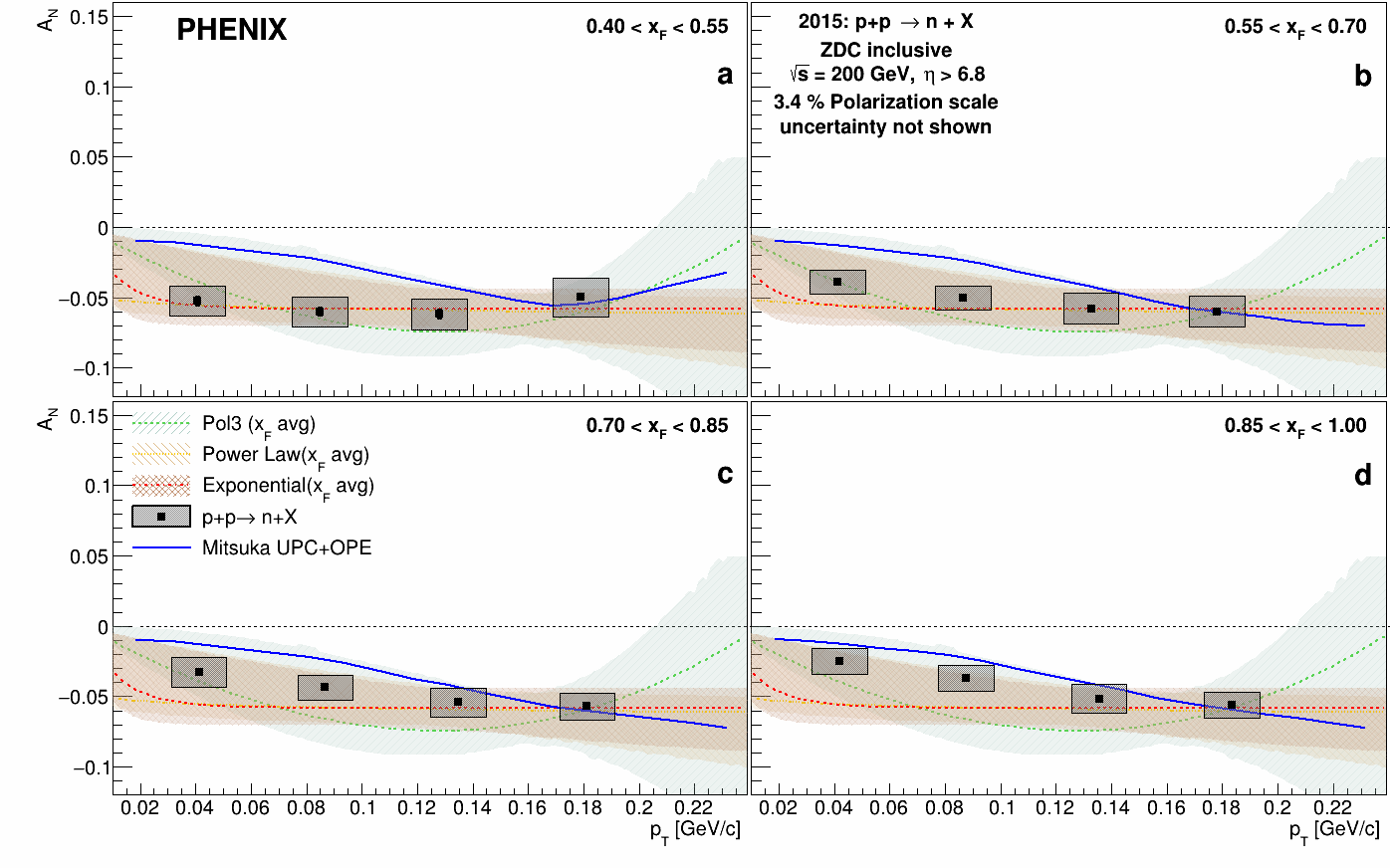
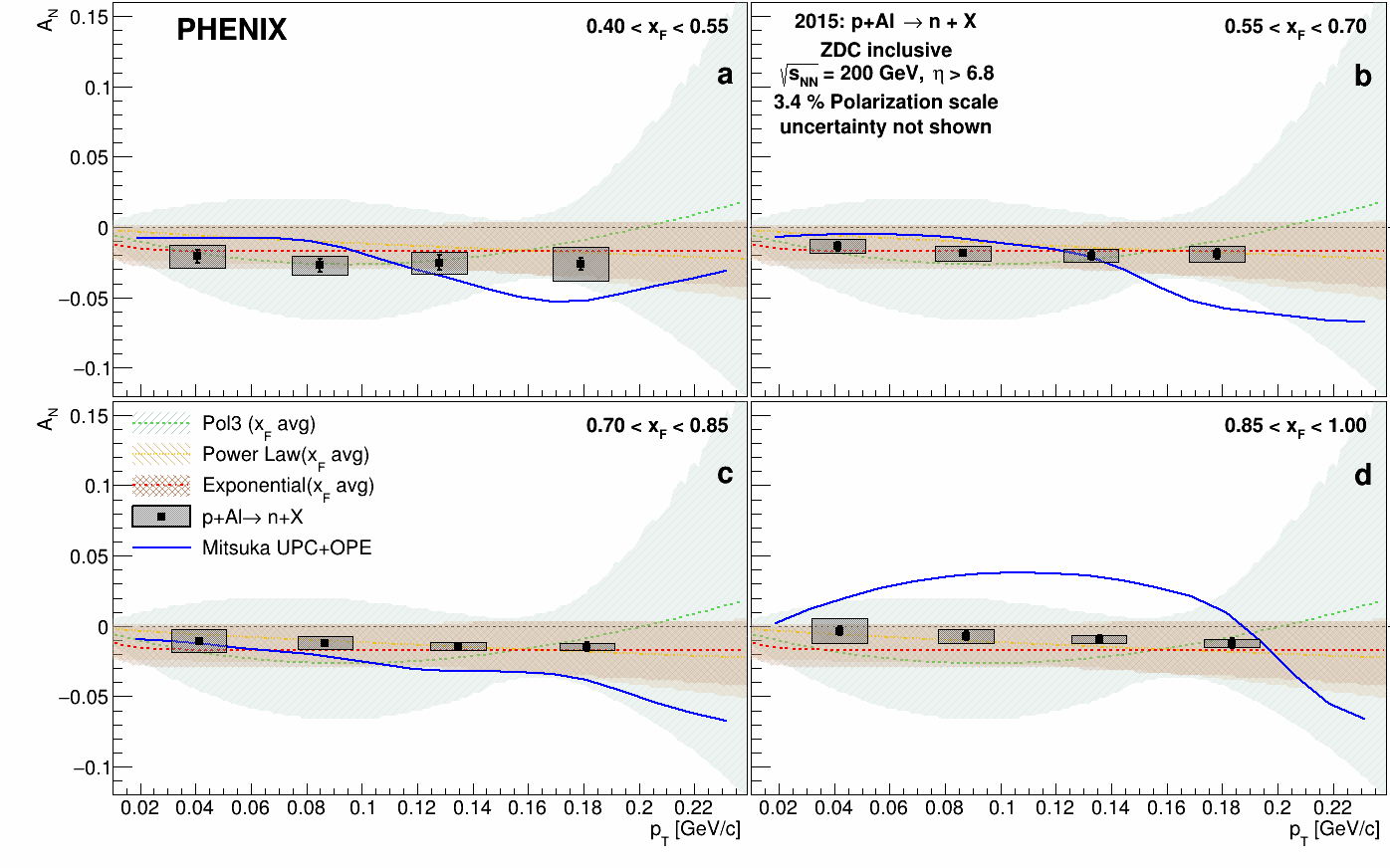
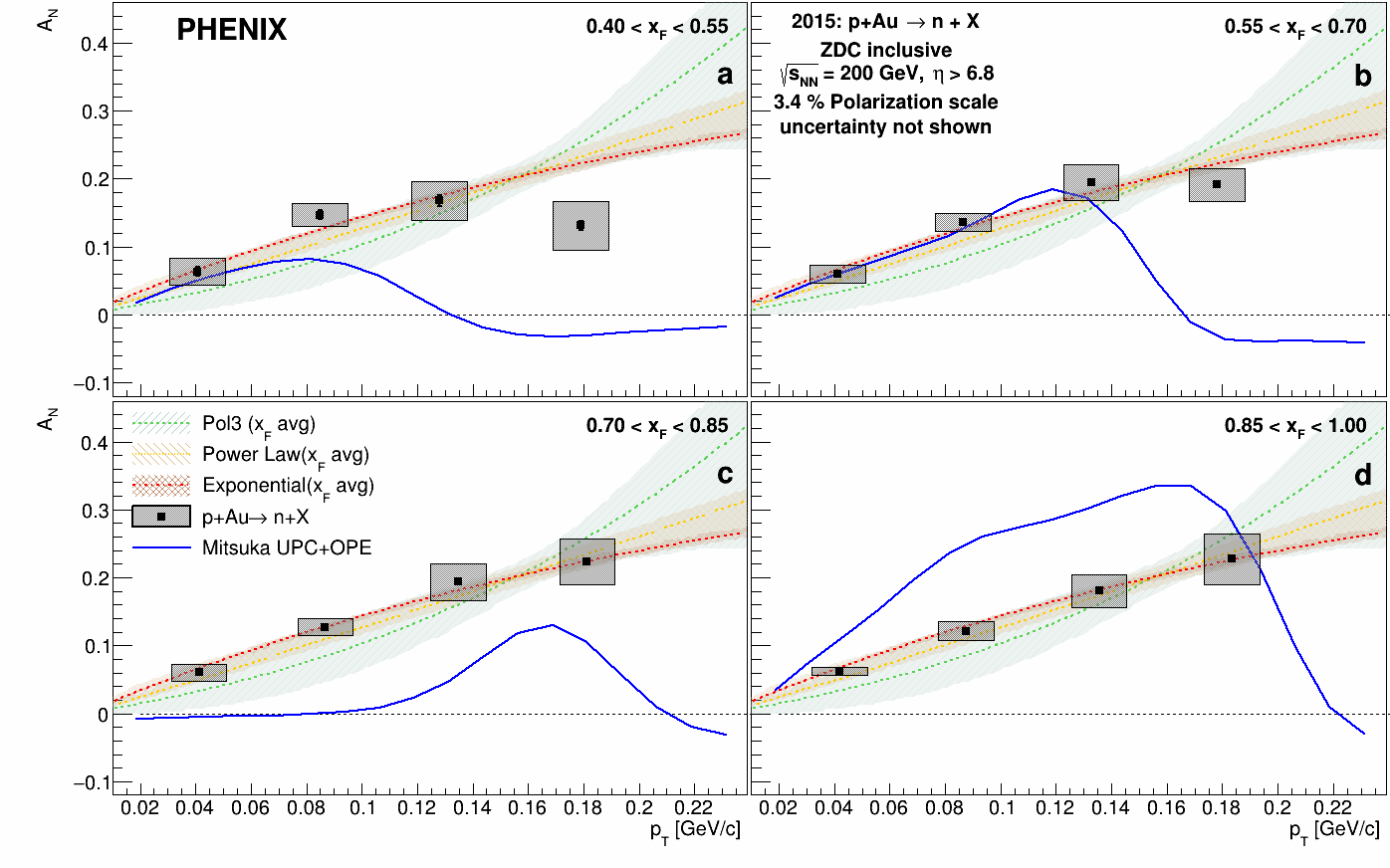
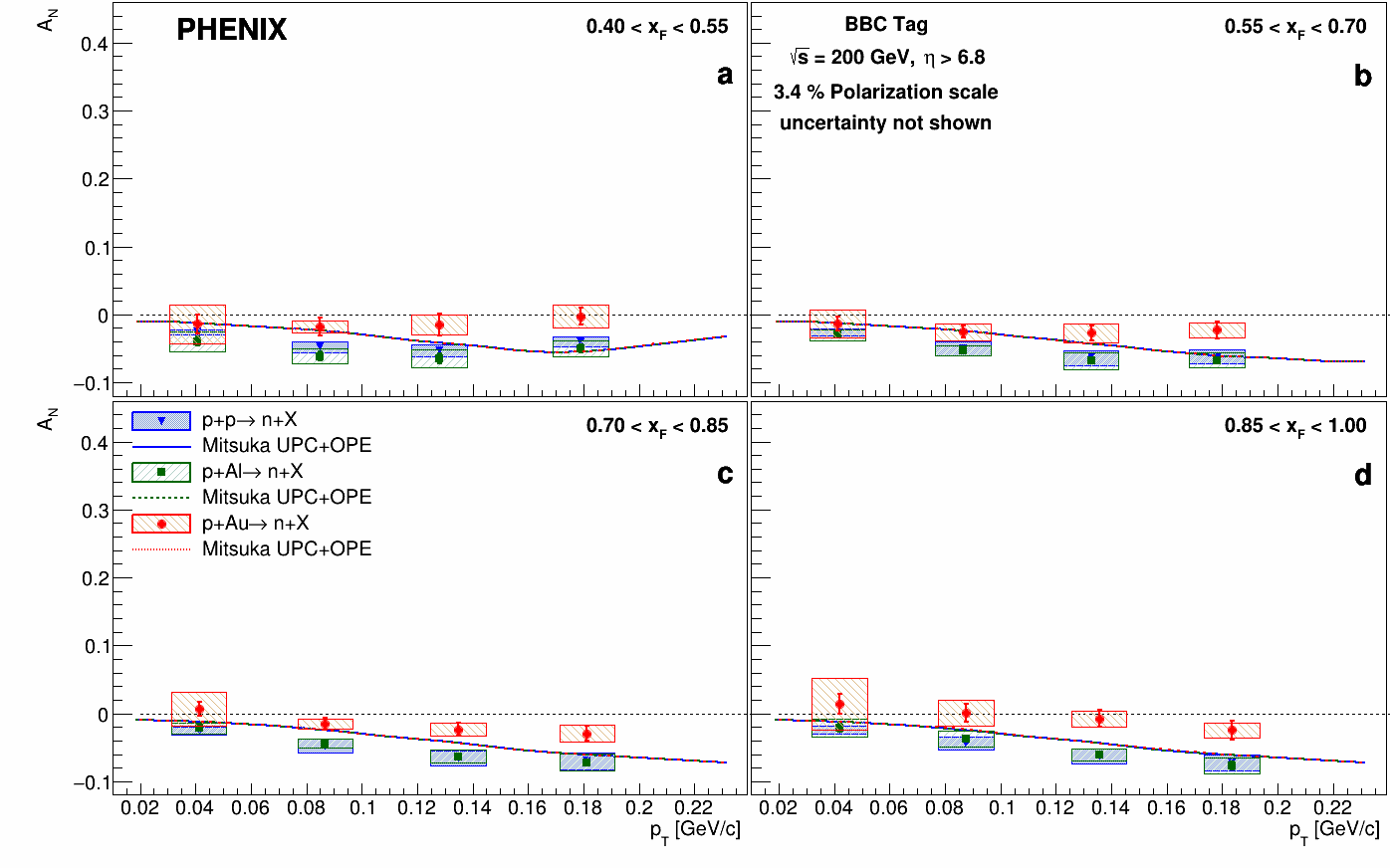
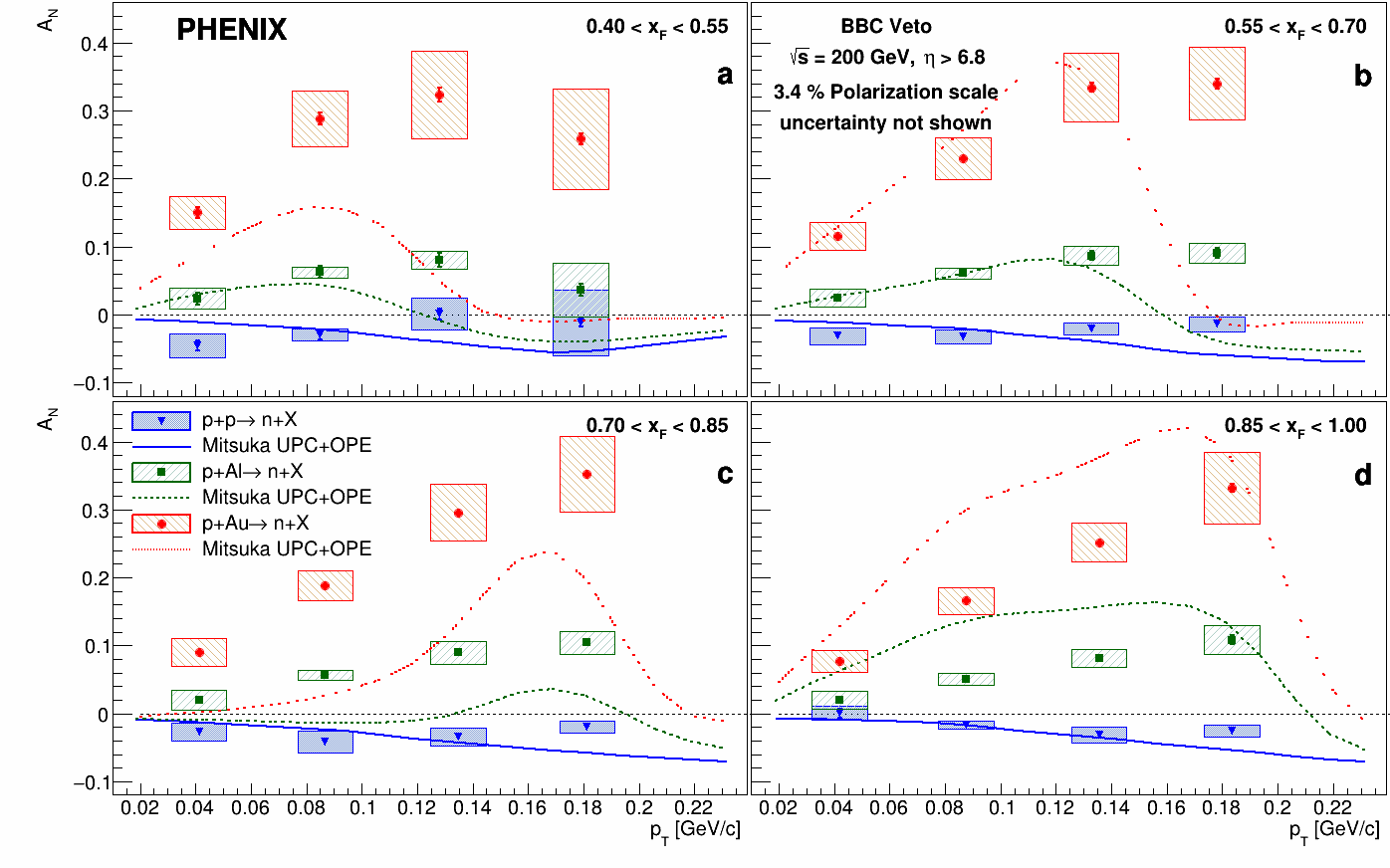
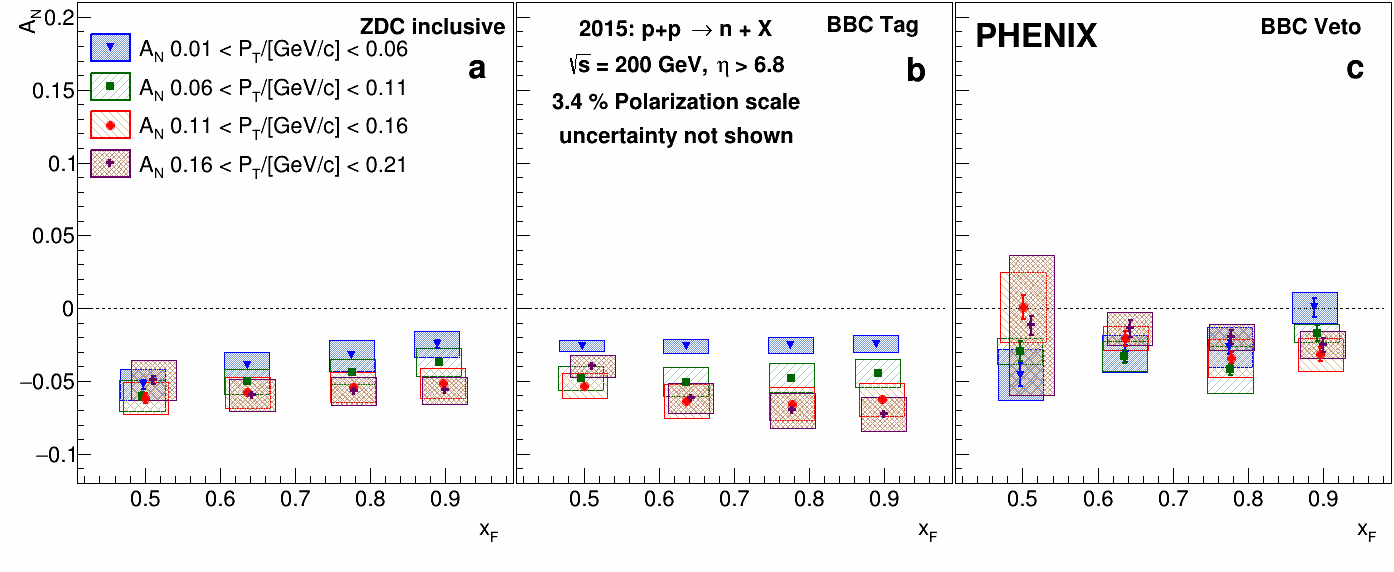
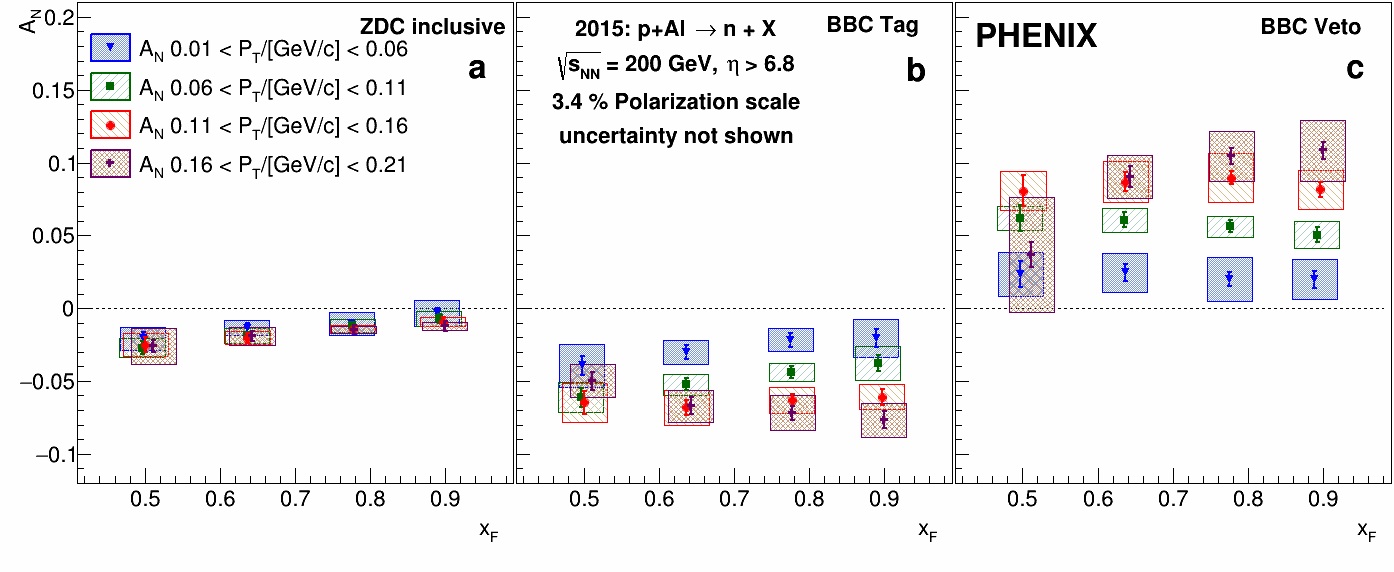
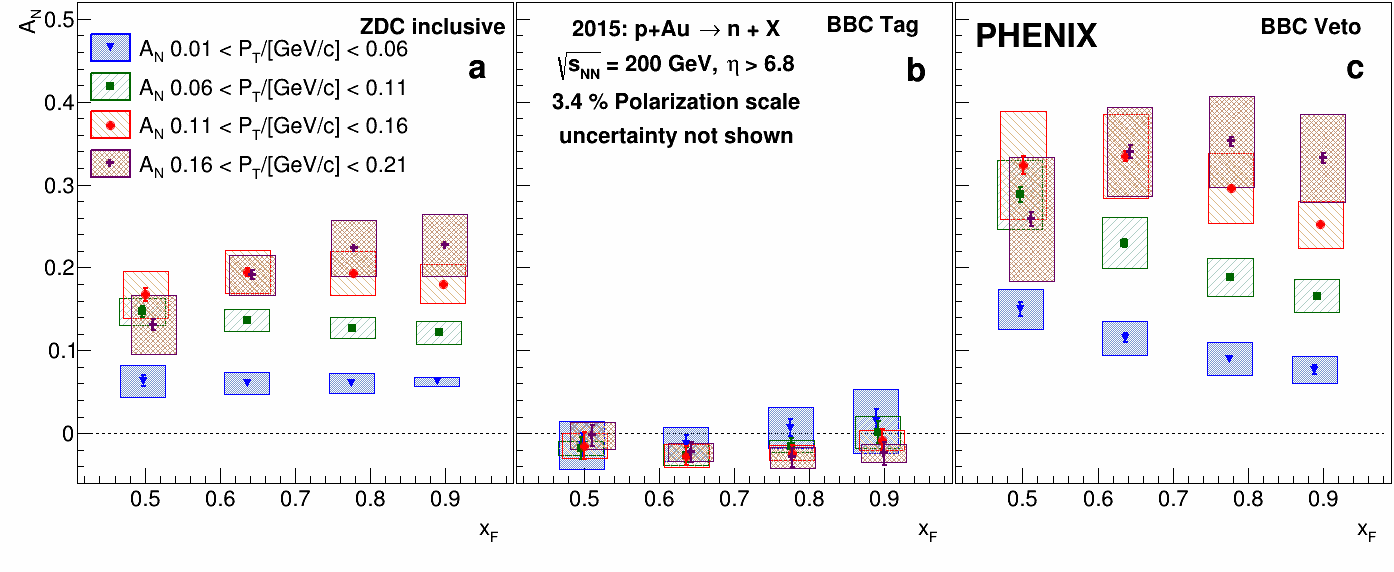
Before discussing the final results, the theory calculations that are used for comparison of the asymmetries need to be discussed. The calculations comprise the aforementioned hadronic interactions of Ref. Kopeliovich et al. (2011) and the UPC based calculations of Ref. Mitsuka (2017). In Ref. Mitsuka (2021) both contributions have been combined, taking into account the mass number dependence of the hadronic interaction from Ref. Guzey and Strikman (2006) as described in Ref. Mitsuka (2015). In these calculations, the unpolarized neutron cross sections for OPE interactions are estimated to be 2.1 mb for collisions, 8.3 mb for Al collisions and 9.4 mb for Au collisions for neutron rapidities above 6.9 and . In contrast, the estimated UPC-based contributions are below 0.1 mb for collisions, 0.7 mb for Al collisions and 19.6 mb for Au collisions Mitsuka (2017).
The calculated asymmetries for hadronic interactions are generally negative and increasing in magnitude with transverse momentum and essentially display no dependence. The UPC-based predictions display a more subtle structure based on the resonances that can be produced initially and their corresponding decay kinematics. At lower transverse momenta the resonance dominantly contributes and creates positive asymmetries overall that are increasing with transverse momentum. At higher transverse momenta other resonances and their three-body decays may also contribute, but are not included in the polarized theory calculation. Therefore the theory calculations predict lower asymmetries. Also the dependence of the UPC-based asymmetry calculations appears to be varying to some extent.
The current maid-based asymmetry projections Drechsel et al. (2007) are limited to invariant masses below 2 GeV/ and resonance decays into a single pion in addition to the neutron while other resonances and decays likely also contribute (as seen, for example, in the unpolarized starlight-based simulations). As a consequence the sharp asymmetry behavior in the studied phase-space may be smoother and in particular may not exhibit such a sharp drop of the asymmetries at slightly higher transverse momenta. In the case of the correlated asymmetries, in addition to these cross section and asymmetry calculations also their relative reconstruction efficiencies need to be taken into account. These efficiencies are taken from the full geant3 simulations. Within the OPE simulations, the efficiencies to fulfill the BBC tagging requirement are predominantly flat in neutron transverse momentum and drop from nearly 65% at small to close to zero when approaches unity. Conversely, the BBC-veto efficiencies range from 15%–20% at low to about 35% close to unity. Overall, within this generator 35% and 17% of all detected neutron events get selected by BBC-tag and BBC-veto, respectively. Note that the remainder of events can be found having only one side of the BBCs showing activity. The other hadronic simulations also show a similar behavior with the actual numbers varying by several percent. In contrast, the UPC simulations have almost no activity in the BBCs with the BBC-veto efficiencies ranging around 85%, and the BBC-tagging efficiencies are at or below 5% throughout the kinematic space covered in these measurements. Overall, 82% of detected neutron events from this generator get selected in the BBC-vetoed case while the BBC-tagged fraction is below one percent. However, other backgrounds such as beam-gas interactions may still create random BBC activity.
Figure 2 shows the results for inclusive collisions as a function of transverse momentum and in bins of . The asymmetries are negative in the whole kinematic region accessed by these measurements. They display a slightly increasing magnitude with increasing transverse momentum except for the lowest bin where the magnitude appears to decrease again. In collisions the interactions are dominated by the hadronic processes and hence the theory calculations are mostly negative and increasing in magnitude. Apart from the lowest bin, they describe the measured asymmetries well.
When studying the inclusive neutron asymmetries in Al collisions, the contribution from UPC events which follows the charge squared of the heavy nucleus will play a larger, but not yet dominating role in the interaction. As a consequence the mostly positive asymmetries from the UPC interaction and the mostly negative asymmetries from the hadron interaction cancel out to a large part as can be seen in Fig. 2. Indeed, the asymmetries are only slightly negative and are often consistent with zero. The theory calculations are again describing the data mostly well. At high some discrepancy is visible where a larger impact of the UPC events is predicted.
In the case of the Au collisions UPC events dominate the interaction and thus the asymmetries become positive as shown in Fig. 3. The asymmetries are rising with increasing transverse momentum in all bins in a similar manner and reach more than 20%. At lower there is an indication of the asymmetries saturating or even falling again which is qualitatively also seen in the theory predictions. The theory calculations show a substantial drop in the asymmetries at higher which is caused by moving away from the resonance where the asymmetries decrease in the UPC calculations. The inclusion of other resonances in these calculations could contribute also in the asymmetries, as they have at least been shown to contribute in unpolarized calculations and the UPC MC generator. This likely also explains the smaller predicted asymmetries at lower in the region where decays also cannot contribute. Again apart from these highest points, one can see that the dependence is mostly weak which can be seen when comparing with the averaged MC reweighting curves.
In the case of the correlated asymmetries the relative weights of the hadronic and ultra-peripheral interactions needed to be added to the theory calculations based on the OPE and UPC MC simulations mentioned above. Generally, a large fraction of hadronic events also fire the BBCs as there is activity in a wide range of rapidities in addition to the very forward region where the neutrons are detected. In contrast UPC interactions, where photons at relatively small scales only excite the proton to a resonance or other nucleon states, very little activity other than from the decay products of these states is expected. Therefore, the overwhelming majority of UPC events do not show any activity in the BBCs. Consequently, the BBC-tagged events are dominated by hadronic interactions and the BBC-vetoed events have a larger UPC contribution depending on the relative contributions of the colliding systems.
Figure 5 displays the BBC-tagged asymmetries as a function of transverse momentum in bins of for , Al, and Au collisions, respectively. The and the Al asymmetries are indeed negative and show a very similar behavior. The asymmetries are increasing in magnitude more than the inclusive neutron asymmetries and reach magnitudes close to 10%. A nearly linear behavior as predicted by Kopeliovich et al. (2011) appears to describe these asymmetries rather well as can be seen also in the combined theory calculations that match the data very well. In the lowest bin there is an indication that at higher the asymmetries become smaller again which actually is well described by the combined theory calculations and thus indicates some residual contribution from the UPC interaction. In Au collisions the asymmetries are generally smaller and only are slightly negative at intermediate . This indicates that some UPC events do remain in Au collisions and dilute the predominantly hadronic asymmetries.
In the case of the BBC-vetoed asymmetries the contributions from UPC interactions are enhanced while those from hadronic interactions are reduced but not eliminated. In collisions these two contributions mostly cancel each other out as can be seen in Fig. 5 where the asymmetries are close to zero in most kinematic regions. A hint of a negative asymmetry at lower transverse momenta is still visible but the asymmetries become smaller as the transverse momentum increases. In Al collisions, the larger UPC contribution now switches the sign of the asymmetries to become positive and rising in transverse momentum, reaching up to 10% at the higher transverse momenta. The dependence is again mostly similar for all bins, but at lower the asymmetry in the highest transverse momentum appears to be dropping similar to the inclusive Au collision case. The theory calculations are again qualitatively comparable with the data, including this drop at higher transverse momenta.
In the BBC-vetoed neutron asymmetries of Au collisions the UPC contributions are even further dominant and the resulting asymmetries are even less diluted by the hadronic interactions. This can be seen by the asymmetries now even exceeding 30%. Given the impact of the produced nucleon resonances on the decay kinematics, here the largest dependence on can be seen with slightly higher asymmetries at low than in higher bins. The drop of the asymmetries at high at lower noted already in the inclusive Au and the BBC-vetoed Al asymmetries is also visible here.
To look more closely at the dependence, Figs. 8 to 8 display the same asymmetries as a function of in bins of transverse momentum. In the collisions, within uncertainties, very little dependence on the longitudinal momentum fraction can be seen overall. The only trends can be seen at low transverse momenta for either inclusive or BBC-vetoed neutron events where the magnitude of the asymmetries becomes smaller with increasing . For the BBC-tagged asymmetries, the magnitude for the lowest bin is smaller at higher transverse momenta.
For neutrons in Al collisions, the inclusive neutron asymmetries appear to be getting smaller in magnitude as a function for all transverse momentum bins. This could be an indication that the relative contribution of UPC events becomes stronger with . A similar behavior is also visible for BBC-tagged neutrons, at least for smaller transverse momenta while it is mostly flat in at higher transverse momenta.
In Au collisions, the neutron asymmetries show again generally a weak dependence on . Only in the BBC-vetoed events a clear trend can be seen for lower transverse momenta where the asymmetries decrease with increasing . At higher transverse momenta the uncertainties become too large to tell whether this trend continues. As mentioned previously, because the UPC based asymmetries closely rely on the resonances that can be formed, this is where one can expect the largest variation of the asymmetries with either kinematic variable.
VI Summary
In summary, the PHENIX experiment has measured single transverse spin asymmetries of very forward neutrons as a function of transverse momentum and longitudinal momentum fraction . The asymmetries were extracted in , Al, and Au collisions and for neutrons that were either inclusively extracted or in (anti)correlation with hard collision-sensitive detectors. The asymmetries show a strong dependence on the collision system which can qualitatively be described by the interplay of hard interactions and ultra-peripheral collisions which strongly depend on the charge of the colliding nucleus. These indications were corroborated by the (anti)correlated results that either enhance or reduce the contributions of the two competing processes. The asymmetries in hadronic processes appear to be negative and increase in magnitude with increasing transverse momentum to up to 10% while hardly any dependence is visible. The UPC related asymmetries in contrast are positive and reach more than 30% in magnitude. Those are also initially rising with transverse momentum while for low a subsequent decrease of the asymmetries is seen. Also at lower transverse momenta some differences in are visible that in the model calculations originate from the different nucleon resonances contributing. The precision and the multi-dimensional dependence of these measurements will greatly improve the general understanding of how hadronic and photon-induced processes create single spin asymmetries at very forward rapidities and at small observed transverse-momentum scales.
Acknowledgements.
We thank the staff of the Collider-Accelerator and Physics Departments at Brookhaven National Laboratory and the staff of the other PHENIX participating institutions for their vital contributions. We acknowledge support from the Office of Nuclear Physics in the Office of Science of the Department of Energy, the National Science Foundation, Abilene Christian University Research Council, Research Foundation of SUNY, and Dean of the College of Arts and Sciences, Vanderbilt University (U.S.A), Ministry of Education, Culture, Sports, Science, and Technology and the Japan Society for the Promotion of Science (Japan), Natural Science Foundation of China (People’s Republic of China), Croatian Science Foundation and Ministry of Science and Education (Croatia), Ministry of Education, Youth and Sports (Czech Republic), Centre National de la Recherche Scientifique, Commissariat à l’Énergie Atomique, and Institut National de Physique Nucléaire et de Physique des Particules (France), J. Bolyai Research Scholarship, EFOP, the New National Excellence Program (ÚNKP), NKFIH, and OTKA (Hungary), Department of Atomic Energy and Department of Science and Technology (India), Israel Science Foundation (Israel), Basic Science Research and SRC(CENuM) Programs through NRF funded by the Ministry of Education and the Ministry of Science and ICT (Korea). Ministry of Education and Science, Russian Academy of Sciences, Federal Agency of Atomic Energy (Russia), VR and Wallenberg Foundation (Sweden), the U.S. Civilian Research and Development Foundation for the Independent States of the Former Soviet Union, the Hungarian American Enterprise Scholarship Fund, the US-Hungarian Fulbright Foundation, and the US-Israel Binational Science Foundation.References
- Flauger and Monnig (1976) W. Flauger and F. Monnig, “Measurement of Inclusive Zero-Angle Neutron Spectra at the ISR,” Nucl. Phys. B 109, 347 (1976).
- Kopeliovich et al. (2008) B. Z. Kopeliovich, I. K. Potashnikova, I. Schmidt, and J. Soffer, “Damping of forward neutrons in collisions,” Phys. Rev. D 78, 014031 (2008).
- Fukao et al. (2007) Y. Fukao et al., “Single Transverse-Spin Asymmetry in Very Forward and Very Backward Neutral Particle Production for Polarized Proton Collisions at GeV,” Phys. Lett. B 650, 325 (2007).
- Togawa (2008) M. Togawa, Measurements of the leading neutron production in polarized collision at =200 GeV, Ph.D. thesis, Kyoto U. (2008).
- Adare et al. (2014) A. Adare et al. (PHENIX Collaboration), “Measurement of transverse-single-spin asymmetries for midrapidity and forward-rapidity production of hadrons in polarized p+p collisions at 200 and 62.4 GeV,” Phys. Rev. D 90, 012006 (2014).
- Kopeliovich et al. (2011) B.Z. Kopeliovich, I.K. Potashnikova, I. Schmidt, and J. Soffer, “Single transverse spin asymmetry of forward neutrons,” Phys. Rev. D 84, 114012 (2011).
- Aidala et al. (2018) C. Aidala et al. (PHENIX Collaboration), “Nuclear Dependence of the Transverse-Single-Spin Asymmetry for Forward Neutron Production in Polarized Collisions at GeV,” Phys. Rev. Lett. 120, 022001 (2018).
- Mitsuka (2017) G. Mitsuka, “Recently measured large for forward neutrons in collisions at GeV explained through simulations of ultraperipheral collisions and hadronic interactions,” Phys. Rev. C 95, 044908 (2017).
- Acharya et al. (2021) U. A. Acharya et al. (PHENIX Collaboration), “Transverse momentum dependent forward neutron single spin asymmetries in transversely polarized collisions at = 200 GeV,” Phys. Rev. D 103, 032007 (2021).
- Adcox et al. (2003) K. Adcox et al. (PHENIX Collaboration), “PHENIX detector overview,” Nucl. Instrum. Methods Phys. Res., Sec. A 499, 469 (2003).
- Brun et al. (1994) R. Brun, F. Bruyant, F. Carminati, S. Giani, M. Maire, A. McPherson, G. Patrick, and L. Urban, GEANT Detector Description and Simulation Tool (1994).
- Roesler et al. (2000) S. Roesler, R. Engel, and J. Ranft, “The Monte Carlo event generator DPMJET-III,” in International Conference on Advanced Monte Carlo for Radiation Physics, Particle Transport Simulation and Applications (MC 2000) (2000) p. 1033, arXiv:hep-ph/0012252 .
- Sjöstrand et al. (2001) T. Sjöstrand, L. Lönnblad, and S. Mrenna, PYTHIA 6.2: Physics and manual (2001), arXiv:hep-ph/0108264 .
- Sjöstrand et al. (2015) T. Sjöstrand, S. Ask, J. R. Christiansen, R. Corke, N. Desai, P. Ilten, S. Mrenna, S. Prestel, C. O. Rasmussen, and P. Z. Skands, “An introduction to PYTHIA 8.2,” Comput. Phys. Commun. 191, 159 (2015).
- Klein et al. (2017) S. R. Klein, J. Nystrand, J. Seger, Y. Gorbunov, and J. Butterworth, “STARlight: A Monte Carlo simulation program for ultra-peripheral collisions of relativistic ions,” Comput. Phys. Commun. 212, 258 (2017).
- D’Agostini (1995) G. D’Agostini, “A multidimensional unfolding method based on Bayes’ theorem,” Nucl. Instrum. Methods Phys. Res., Sec. A 362, 487 (1995).
- Adye (2011) T. Adye, “Unfolding algorithms and tests using RooUnfold,” in PHYSTAT 2011 (CERN, Geneva, 2011) p. 313, arXiv:1105.1160 [physics.data-an] .
- Brun and Rademakers (1997) R. Brun and F. Rademakers, “ROOT: An object oriented data analysis framework,” Nucl. Instrum. Methods Phys. Res., Sec. A 389, 81 (1997).
- Höcker and Kartvelishvili (1996) A. Höcker and V. Kartvelishvili, “SVD approach to data unfolding,” Nucl. Instrum. Methods Phys. Res., Sec. A 372, 469 (1996).
- pol (2018) “The RHIC polarimetry group, note no 490,” (2018).
- Mitsuka (2021) Gaku Mitsuka, “Private communication based on Mitsuka (2017),” (2021).
- Guzey and Strikman (2006) V. Guzey and M. Strikman, “Proton-nucleus scattering and cross section fluctuations at RHIC and LHC,” Phys. Lett. B 633, 245 (2006).
- Mitsuka (2015) G. Mitsuka, “Forward hadron production in ultra-peripheral proton–heavy-ion collisions at the LHC and RHIC,” Eur. Phys. J. C 75, 614 (2015).
- Drechsel et al. (2007) D. Drechsel, S. S. Kamalov, and L. Tiator, “Unitary Isobar Model- MAID2007,” Eur. Phys. J. A 34, 69 (2007).